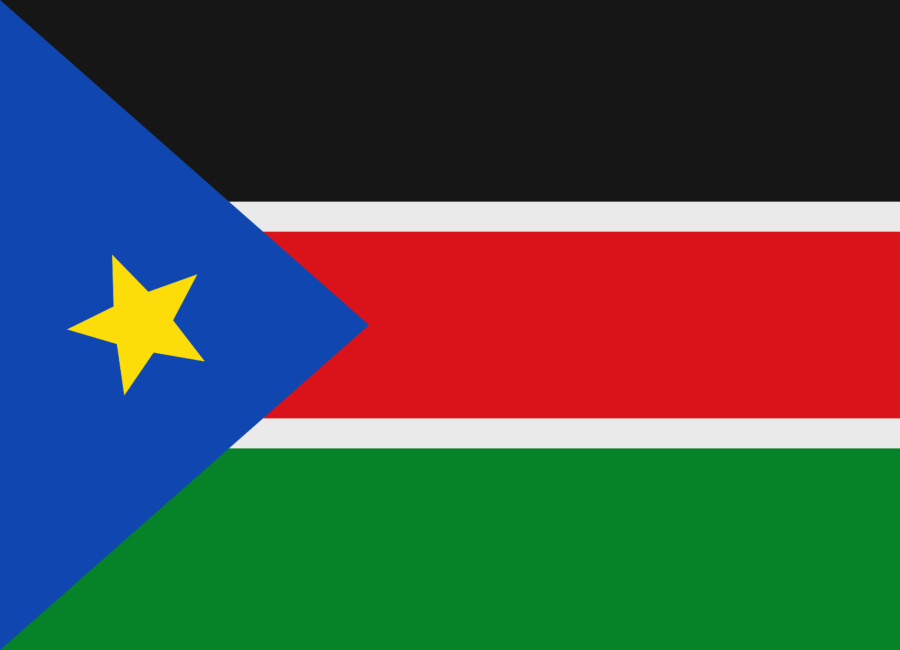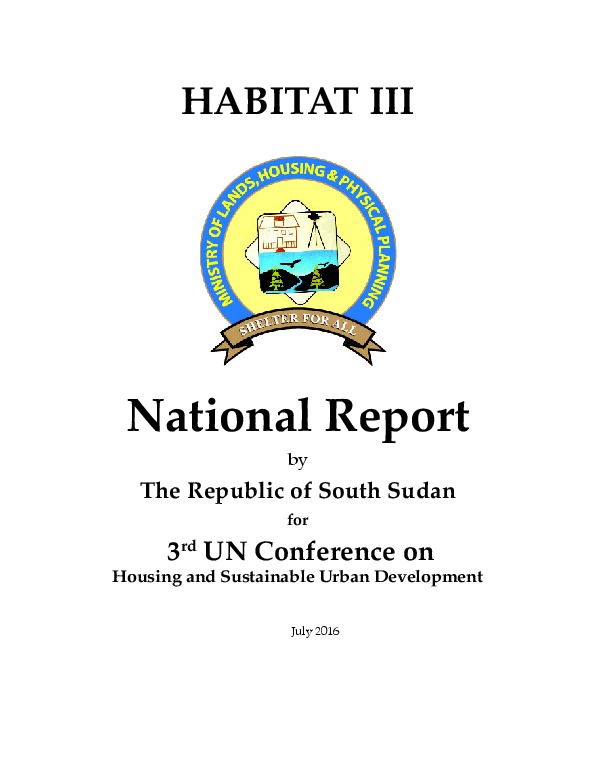
South Sudan
Urban indicators:
| Value | Year | ||
| Surface area (sq km) | 658841 | 2014 | |
| Population (proj., 000) | 12733 | 2016 | |
| Pop. density (per sq km) | 20.8 | 2016 | |
| Capital city | Juba | 2015 | |
| Capital city pop. (000) | 321 | 2015 | |
| Population growth rate (average annual %) | 4.1 | 2010-2015 | |
| Urban population growth rate (average annual %) | 5.1 | 2010-2015 | |
| CO2 emission estimates (000 tons/tons per capita) | 1448/0.1 | 2013 | |
| Population using improved drinking water sources (urban/rural, %) | 66.8/56.9 | 2015 | |
| Population using improved sanitation facilities (urban/rural, %) | 16.4/4.5 | 2015 |
| 1995 | 2005 | 2014/2015 | |
| Urban population ('000) | 863 | 1,379 | 2,285 |
| Level of urbanization (%) | 15.9 | 17.2 | 18.8 |
| Proportion of urban population living in slum areas (%) | ... | ... | 95.6 |
| Urban Slum Population ('000) | ... | ... | 2,086 |
| Value | Year | |
| Urban poverty headcount ratio based on national poverty lines | 24.4% | 2009 |
National Report:
National Report Executive Summary:
INTRODUCTION
In 1976, the United Nations convened the Habitat I conference in Vancouver, Canada, when governments began to recognize the consequences of rapid urbanization, particularly in the developing world. Twenty years after the Habitat I conference, commitments to addressing the consequences of rapid urbanization were reaffirmed at the Habitat II conference in 1996 in Istanbul, Turkey. At the Habitat II conference, world leaders adopted the Habitat Agenda. The Habitat Agenda read “Solidifying a Global, Multi-stakeholder Commitment to a Set of Principles and Plan of Action in Pursuit of Adequate Shelter for all and Sustainable Human Settlements Development in an Urbanizing World”.
In 2016, the Habitat III conference will be held, twenty years after Habitat II. Like Habitat II, Habitat III will de ne global urban priorities for the next twenty years. The Habitat III conference will generate a New Agenda for the 21st century, which will recognize the changing dynamics of human civilization, and (Source: https://unhabitat.org).
In preparation for the first meeting of the Preparatory Committee for the Habitat III conference, that will be held in September 2014, Governments were required to prepare Habitat III National Reports. The Habitat III National Reports will evaluate/review the implementation of the Habitat II agenda, as well as identify new challenges and emerging trends. The reports will also propose a future vision for sustainable human settlements and urban development, as a basis for the formulation of a New Agenda.
The preparation of the Habitat III National Report focused on the following thematic areas; demographic issues, national urban policies, urban planning and design, housing, land and security of tenure, urban economy and employment, disasters and resilience, environment and climate change and any other key issues deemed important within the national context.
In South Sudan, a need to embark on this assignment became even imperative considering the emerging needs for housing and basic services. The independence of South Sudan in 2011 created a new hope for prioritizing, identifying and aligning our national agenda to the global Agenda. Habitat III national report could not have come in a better time than now.
Based on the requirement and specification of compiling a refined report for the country, a series of consultative meetings and seminars were organized locally and country-wide level respectively. Prior sensitization meeting were designed and arranged and prepared along the following thematic areas: Population and Demography, Urban Planning and Design; Urban Economy; Housing and Basic Services; Social Development; Environment Management and Urbanization; Transport and Mobility; and Urban Governance.
Summary of Activities Undertaken: In addition to the meeting that was held between the Directorate of Housing and the National Habitat Committee, both the Secretariat and the Consultant embarked on a review of literature to the scope of the assignments exercise. Below are documents the group has gathered and reviewed;
- Media publications, Newspapers, Seminars, Workshops and meetings
- The Draft Urbanization Policy (Draft in October, 2013)
- The Draft National Housing Policy (2012) and strategic plans approved by Cabinet in 2013
- Urban Housing Sector Pro le (Compiled in June 2012)
- Reports on Housing Finance Corporation (Drafted and approved by CoM in 2013)
- The Draft South Sudan Land Policy (2013)
- South Sudan Development Plan (2010/11 – 2014/15)
- State of South Sudan Population Report; “Planned Urbanization for South Sudan’s Growing Population (Drafted in 2013)
- Reports on Slum Upgrading (Drafted in 2013)
- Engineering Coucil of South Sudan Act (2012)
- Reports on the State of the Economy
- Laws and Regulations (Draft concept paper on Physical Planning Policy 2014; Public Health Act, and among others)
- The Land Act, (2009)
- Telecommunication and Postal Services Sector Policy Framework, (2008)
- South Sudan Development Initiative, (2015)
- South Sudan Transport Sector and strategic plans approved by Cabinet in April 2013
- Terms of Reference for Consultancy services to develop South Sudan’s Transport Master Plan 2015 – 2025
This Report constitutes the final deliverable of this assignment. From the onset, the Consultant wishes to state that what was presented in the inception and interim reports remains valid and, therefore, need not be further elaborated upon. The contents of this Report are, largely intended to establish consensus and to consolidate mutual endorsement of the Terms of Reference (TOR) between the Employer (MLHPP) and the Consultant to achieve a common objective of producing a harmonized National Habitat III Country Report. The final report articulates the outcome of the various consultations, which took place during the months of August and November 2014, and taking note of inputs, observations, findings and recommendations.
Statistics:
Urban housing indicators
Urban population with access to adequate housing (%)
Basic services and infrastructure
Urban population with access to safe drinking water (%)
Urban population with access to adequate sanitation (%)
Urban population with access to regular waste collection (%)
Urban population with access to clean domestic energy (%)
Level of effective decentralization
Share of both income and expenditure allocated to local governments from the national budget (%)
Statements by other countries on behalf of African Group and G77 and China:
-
Habitat III Plenaries
-
Intersessionals: Informal Intergovernmental Meetings (May 2016)
- Statement - 18 May (by Thailand) - English Made by Thailand on Behalf of G77 and China
- Statement – 18 May (by Nigeria, 1) - English Made by Nigeria on Behalf of African Group
- Statement - 18 May (by Jamaica) - English Made by Jamaica on Behalf of G77 and China
- Statement – 18 May (by Nigeria, 2) - English Made by Nigeria on Behalf of African Group
- Statement - 19 May (by Jamaica) - English Made by Jamaica on Behalf of G77 and China
- Statement – 19 May (by Nigeria, 1) - English Made by Nigeria on Behalf of African Group
- Statement - 19 May (by Kenya) - English Made by Kenya on Behalf of G77 and China
- Statement – 19 May (by Nigeria, 2) - English Made by Nigeria on Behalf of African Group
- Statement - 20 May (by Jamaica) - English Made by Jamaica on Behalf of G77 and China
- Statement – 20 May (by Nigeria, 1) - English Made by Nigeria on Behalf of African Group
- Statement - 20 May (by Thailand) - English Made by Thailand on Behalf of G77 and China
- Statement – 20 May (by Nigeria, 2) - English Made by Nigeria on Behalf of African Group

